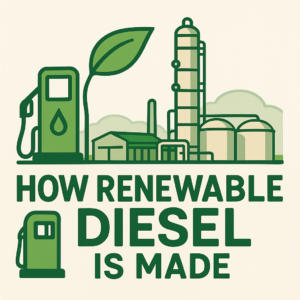Renewable diesel is a type of biofuel called biomass based diesel

How is Renewable Diesel made?
Very similarly to fossil fuel diesel.
In the 1990’s the world started moving towards an ultra-low sulfur diesel fuel specification. Over decades we have arrived to where even marine fuels are running a lower sulfur fuel. The technology used to achieve this is hydrotreating the distilled crude oils. By use of hydrocrackers, the molecules of petroleum crude oils are cracked and reformed into ultra-low sulfur diesel. The use of hydrotreating diesel fuels has enabled the removal of sulfur and then enabling the use of emissions systems that not only reduce acid rain but also smog causing emissions like NOx. This advanced petroleum refining chemistry technology is the forebearer to today’s renewable diesel technologies. The technical chemistry of taking a feedstock, cracking the molecules and reforming them into a final product is where renewable diesel comes from.
Renewable diesel is a type of biofuel that is chemically similar to petroleum diesel and can be used in any diesel engine. It can be produced from various feedstocks, such as vegetable oils, animal fats, waste cooking oil, and algae. Renewable diesel can reduce greenhouse gas emissions and improve air quality compared to petroleum diesel⁵. The inputs for renewable diesel are typically low value but high btu value feedstocks. From virgin soy bean and canola oils to the lowest grade municipal wastes. The modern chemistry of today’s petrochemical industry transforms them into the highly sought fuels.
There are two processes making renewable diesel. Hydrogenation and Fischer Tropsch Pyrolysis.
The most common way to produce renewable diesel is by hydrotreating, commonly referred to as hydrocracking, which involves reacting the feedstock with hydrogen under high temperature and pressure in the presence of a catalyst. Renewable diesel made with this process is often called Hydogenated Vegetable Oil (HVO). HVO and Renewable Diesel are the same fuel. Utility scale power generation often will refer to HVO as their technical term for this low CO2 biofuel.
How HVO is made is extremely similar to crude fossil fuel. The investments to do it also cost billions of dollars similar to the costs of petroleum refining. Imagine a vegetable or animal fat being put under pressure, the molecules are cracked into smaller chain molecules and as this stream of feedstock is passed in the presence of a catalyst as hydrogen is added it forms hydrocarbon molecules like diesel, jet fuel, and propane. This process removes oxygen, sulfur, nitrogen, and other impurities from the feedstock and converts it into hydrocarbons that are similar to those in petroleum diesel⁴⁵. Hydro processing is also used in petroleum refineries to upgrade crude oil into various fuels, such as renewable diesel.
Other ways to produce renewable diesel include pyrolysis, usually using a Fischer Tropsch process. Pyrolysis is usually made from high energy content dry garbage. Think wood waste, plastics, tires, and other high Btu content waste streams. These garbage feedstocks are transformed into hydrocarbons with a process of heating the feedstock in the absence of oxygen to produce a liquid bio-oil that can be further upgraded into renewable diesel; gasification, which involves converting the feedstock into a mixture of carbon monoxide and hydrogen (syngas) that can be synthesized into renewable diesel; and biochemical and thermochemical technologies, which involve using enzymes, microorganisms, or catalysts to convert the feedstock into renewable diesel⁴.
According to the U.S. Energy Information Administration (EIA), U.S. production capacity for renewable diesel could increase significantly through 2030, based on several announced and developing projects. This growth is driven by higher state and federal targets for renewable fuel, favorable tax credits, and the conversion of existing petroleum refineries into renewable diesel refineries². As of the end of 2020, U.S. renewable diesel production capacity totaled nearly 0.6 billion gallons per year (gal/y), or 38,000 barrels per day (b/d). Several projects currently under construction or completed can jump this capacity up billions of gallons. could increase this capacity by 2.4 billion gal/y; proposed and announced projects would add another 1.8 billion gal/y by 2024. If all projects come online as intended, U.S. renewable diesel production would total 5.1 billion gal/y (330,000 b/d) by the end of 2024².
Globally, over 1.45 billion gallons of renewable diesel are produced annually and are forecasted to grow up to 3.34 billion gallons in 2024. Neste, a Finland based petroleum refining company, is currently dominating the production of renewable diesel¹. Other major producers in the United States include Chevron, BP, Seaboard Energy, Phillips 66, HF Sinclair, Montana Renewables, Marathon, and Diamond Green Diesel¹.
Resources:
(1) Renewable Diesel – Alternative Fuels Data Center.
(2) Renewable Diesel and Biodiesel Basics – EIA
(3) U.S. renewable diesel capacity could increase – EIA
(4) Renewable Diesel: The Fuel of the Future – FutureBridge.
(5) Overview of the Production Capacity of U.S. Renewable Diesel Plants

